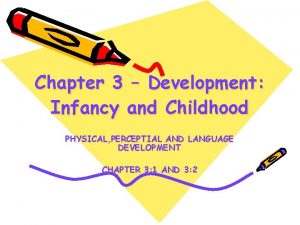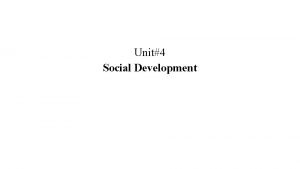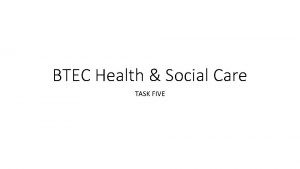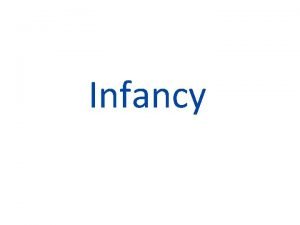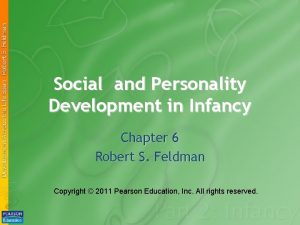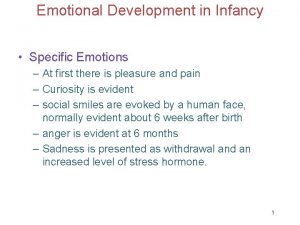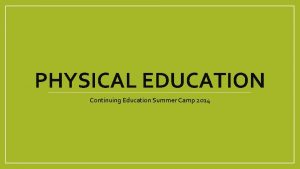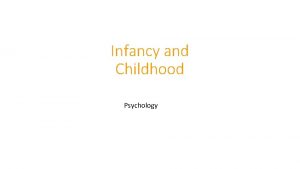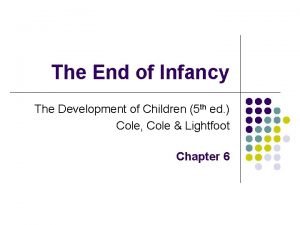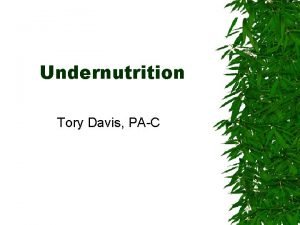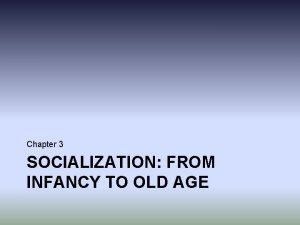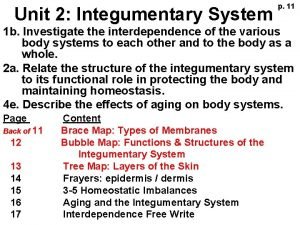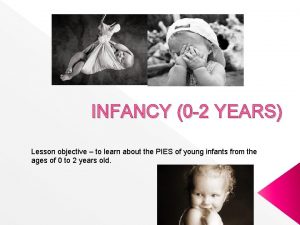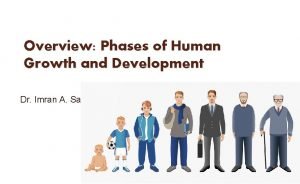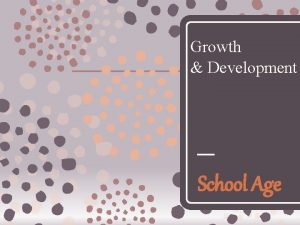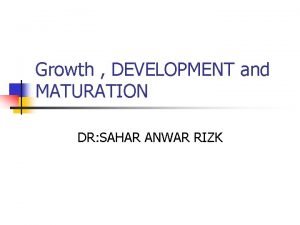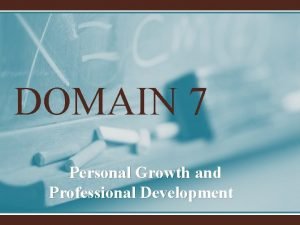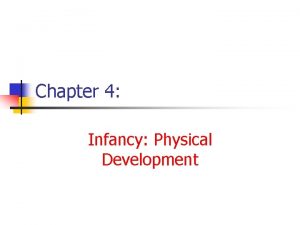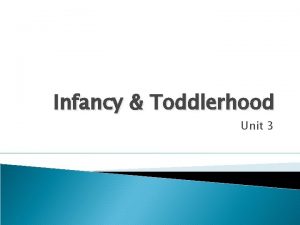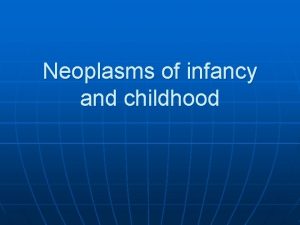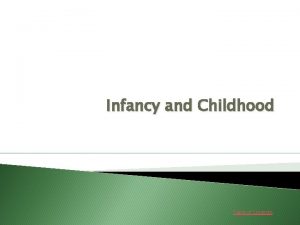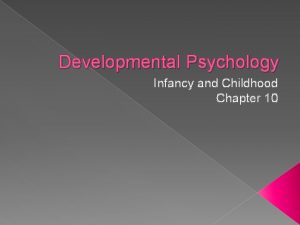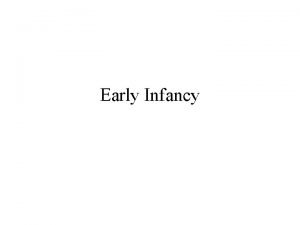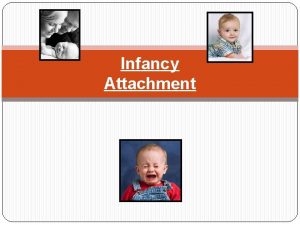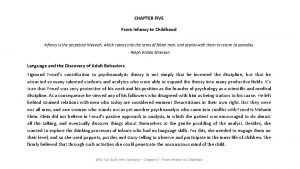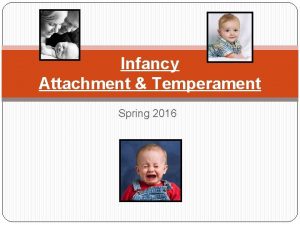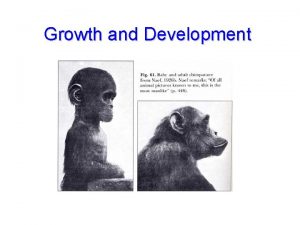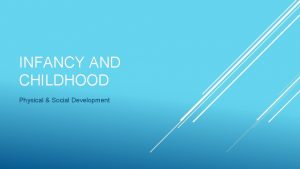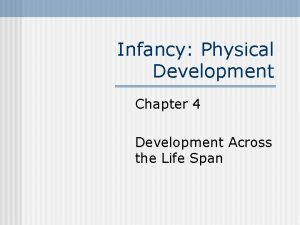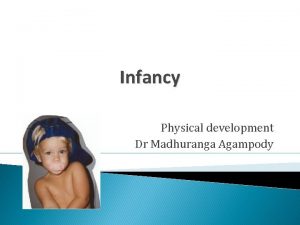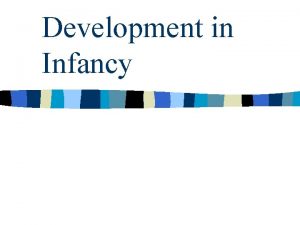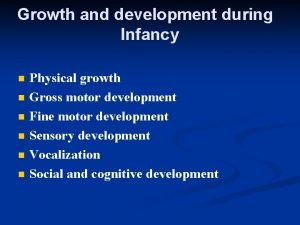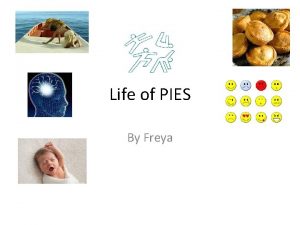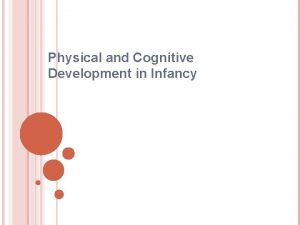Infancy Physical Development Physical Growth and Development OT














































- Slides: 46

Infancy: Physical Development Physical Growth and Development OT 500 Spring 2016

What Are the Sequences of Physical Development? � Cephalocaudal Development ◦ Upper part of the head to the lower parts of the body � Proximodistal Development ◦ Trunk outward – from body’s central axis toward periphery � Differentiation ◦ Tendency of behavior to become more specific and distinct

What Patterns of Growth Occur in Infancy? �Weight doubles at about 5 months; triples by first birthday �Height increase by 50% in first year �Infants grow 4 to 6 inches in second year; and gain 4 to 7 pounds �Growth for the most part appears continuous but actually it occurs in spurts

One week

6 weeks

2 months

3 months

4 Months

5 Months

6 months

7 months

8 Months

9 months

Growth Curves for Weight and Height Figure 5. 1

Changes in Body Proportions � Children’s heads are proportionately larger than adults’ ◦ Cephalocaudal development � Changes in proportion of arms and legs

What Is Failure to Thrive? � Growth impairment during infancy and early childhood � Causes may be organic or non-organic � Biologically based or non-biologically based ◦ Marasmus; Condition related to FTT; Diet low in essential nutrition � Linked to physical, cognitive, behavioral, and emotional problems � Deficiencies in caregiver-child interaction may play a role � Canalization – catch up growth once FTT is resolved

What Are the Nutritional Needs of Children? � Infants require breast milk or iron fortified formula � Solid foods may be introduced about 4 to 6 months ◦ Iron-enriched cereal, strained fruits, vegetables, and meats � Whole cow’s milk delayed until 9 to 12 months ◦ Teething biscuits in later part of first year

Why Do Women Bottle-feed or Breastfeed their Children? � � � Choice to breastfeed is influenced by ◦ Domestic and occupational arrangements ◦ Attitudes regarding benefits for bonding and infant health ◦ Fear of pain, unease with breastfeeding, and public breastfeeding ◦ Community and familial support; Level of education Colostrum early form of breast milk Advantages of breast milk ◦ Conforms to digestion process, possesses needed nutrients with a ◦ ◦ ◦ high level of nutrients into low volume Contains mother’s antibodies; Protects against childhood lymphoma Helps protect against infant diarrhea; Is less likely than formula to cause allergies Helps prevent obesity later in life Maternal health benefits Human newborns prefer it; It’s free

What Are the Disadvantages of Breast Milk? � Disadvantages of breast milk ◦ HIV, alcohol, drugs, and environmental hazards may be transmitted through breast milk ◦ Mother must be adequately nourished ◦ Physical demands on mother � Lack of social support � Return to work – pumping can be too demanding � Stress and mastitis � What about mothers who smoke? ◦ No harmful effects on infants have been noted ◦ Can reduce milk supply

Development of the Brain and Nervous System

Neurons (contain cell body, dendrites, axon; the axon is coated with myelin) � Neurons are the basic unit of nervous system; they receive and transmit messages; formation of neurons is complete at birth � Neurons vary according to function and location; As child matures, neuronal axons grow in length, Dendrites and Axon terminals proliferate so that connections or networks become more complex � Myelin makes messages more efficient; myelination occurs with maturation through childhood; Inhibition of myelination results in disease such as multiple sclerosis

Anatomy of a Neuron Figure 5. 3

Brain Development � The brain is the command center of organisms � Brain of neonate weighs less than one pound; By the child’s first birthday, the brain triples in weight, reaching nearly 70% of adult weight � Brain Structures include the ◦ Medulla : heartbeat, respiration ◦ Cerebellum: Maintains balance, control motor behavior, coordinate eye movements with body sensations ◦ Cerebrum: Allows human learning, thought, memory, language

Growth of Body Systems as a Percentage of Total Postnatal Growth Figure 5. 4

Structures of the Brain Figure 5. 5

How Does the Brain Develop? � Growth Spurts in Brain Development ◦ Prenatal - during 4 th and 5 th months �Proliferation of neurons ◦ 25 th week prenatal through end of second year after birth �Proliferation of dendrites and axon terminals

Increases in Neural Connections in the Brain Figure 5. 6

Brain Development in Infancy � At birth, brain areas well myelinated include ◦ Heartbeat and respiration ◦ Sleeping and arousal ◦ Reflex activity � Intentional physical activity coincides with myelination � Myelination of sensory areas ◦ Hearing – begins about 6 th month of pregnancy and continues to age 4 ◦ Vision – begins shortly before full term but develops rapidly

How Do Nature and Nurture Affect the Development of the Brain? � Brain development is affected by maturation (nature) and sensory stimulation and motor activity (nurture) ◦ Rats in enriched environment �More synapses per neuron ◦ Human infants have more neural connections than adults �If activated by experience, connection survives �If not activated, connection does not survive ◦ Adequate nutrition is necessary

Motor Development

Motor Development in Infancy � � � Follows cephalocaudal and proximo-distal patterns Develop postural control , balance and stability; further development of the musculoskeletal system Many infant motor primitive reflex patterns are “Integrated”; replaced by higher level, voluntary controlled movements; Develop automatic reactions like righting, equilibrium, and protective reactions Gross motor skills develop; coordination, muscle strength, endurance, and agility; Fine motor skills including reaching and grasping, hand use, dexterity, visual- motor coordination, bilateral coordination MAJOR MOTOR MILESTONES: �Rolling over supine to prone, 3 -4 months �Rolling over prone to supine 4 -6 months �Sits up 5 -7 months; Belly crawls 5 -7 months �Crawls on hands and knees 7 -9 months �Pulls to stands and cruises holding onto something 9 -11 months �Walks 10 -14 months

Control of the Hands; Fine Motor Skills Newborns track objects with eyes but do not reach for them � Grasp reflex (dominates until about 3 rd month) � ◦ Grasp but do not release intentionally � Voluntary grasping about 3 months ◦ Ulnar grasp, then radial grasp; gross fisted grasp patterns ◦ Pincer grasp with thumb opposition around 9 -13 months ◦ Able to transfer toys from one hand to the other around 4 -6 months ◦ Voluntary release with some control around 10 -14 months; can stack 2 one inch block around 15 months � Visual – motor coordination developing; copy simple horizontal and vertical lines 2 -2. 5 years of age

Pincer Grasp Figure 5. 7

Other gross motor skills ◦ Walk backwards ◦ Run ◦ Kick a ball ◦ Jump (clearing both feet together) ◦ Jump down from a raised surface ◦ Catch a large ball ◦ Move a push riding toy ◦ Climb up stairs; Climb down stairs ◦ Ride/Pedal a trike ◦ Climb in and out crib ◦ Climb into a car seat

Motor Development in Infancy Figure 5. 8

Creeping Figure 5. 9

Walking Figure 5. 10

What Are the Roles of Nature and Nurture in Motor Development? � Maturation (nature) ◦ Myelination and differentiation is needed for certain voluntary motor activities � Experience (nurture) ◦ Experimentation to achieve milestones ◦ Slight effect in training to accelerate motor skills � Reaction range ◦ Limits for the expression of inherited traits

Native American Hopi Infant Strapped to a Cradle Board Figure 5. 11

Sensory and Perceptual Development

Development of Visual Acuity and Peripheral Vision � Neonates are nearsighted ◦ Greatest gains in visual acuity between birth and 6 months ◦ By about 3 to 5 years of age, approximate adult levels � Neonates have poor peripheral vision ◦ Perceive stimuli within 30 degree angle ◦ By 7 weeks increases to 45 degrees ◦ By 6 months of age, equal to adult (90 degrees)

What Captures the Attention of Infants? How Do Visual Preferences Develop? � Neonates attend longer to stripes than blobs ◦ By 8 to 12 weeks, prefer curved lines over straight � Infants prefer faces ◦ Discriminate maternal and stranger faces ◦ Prefer attractive faces ◦ Pay most attention to edges ◦ Depth Perception: Develops around 6 months (onset of crawling) Research using the Visual Cliff; Gibson and Walk (1960) show infants will not go off the deep end!

The Development of Perceptual Constancies? (Size, shape) � � � Perceptual constancy – perception of object remains stable although sensations may differ under various conditions Size constancy – perception of object’s size remains stable although retinal size may differ due to distance; abilty documented in early infancy Shape constancy – perception of object’s shape remains stable although shape on retina may change due to looking at objects from various perspectives; ability seen as early as 4 -5 months of age.

How Does the Sense of Hearing Develop in Infancy? � Neonates can orient toward direction of a sound ◦ 18 months locate sounds as well as adults � � Infants exposed to moderate noise levels as background habituate to it and are less likely to waken due to noise By 1 month, infants perceive differences between similar speech sounds By 3½ months discriminate caregivers’ voices Infants perceive most speech sounds present in world languages ◦ By 10 to 12 months, lose capacity to discriminate sounds not found in native language

Development of Coordination of the Senses � Infants recognize that objects experienced by one sense are the same as those experienced by another ◦ Looked longer at novel items than those previously handled

Do Children Play an Active or Passive Role in Perceptual Development? Role of Nature and Nurture � � Neonates’ role in perceptual development is largely passive early on Later, a child’s role in perception becomes more active as they gain some control over what they look at, where they go; start to develop interests and preferences so that their attention becomes selective, and irrelevant information ignored � � Some in-born ways of responding to sensory stimuli; may be some sensitive periods for vision Nature and nurture equally important in perceptual development
 Slidetodoc
Slidetodoc Internally programmed growth of a child
Internally programmed growth of a child Rovee-collier
Rovee-collier Social development in infancy and childhood
Social development in infancy and childhood Module 47 infancy and childhood cognitive development
Module 47 infancy and childhood cognitive development Intellectual in health and social care
Intellectual in health and social care Module 47 infancy and childhood cognitive development
Module 47 infancy and childhood cognitive development Chapter 5 cognitive development in infancy and toddlerhood
Chapter 5 cognitive development in infancy and toddlerhood Infancy physical changes
Infancy physical changes Socioemotional development in infancy
Socioemotional development in infancy Infancy psychosocial development
Infancy psychosocial development Stage growth and development
Stage growth and development Personality development in infancy
Personality development in infancy Personality development in infants
Personality development in infants Emotional development in infancy
Emotional development in infancy Growth and development in physical education
Growth and development in physical education Infancy and childhood psychology
Infancy and childhood psychology Psychology chapter 10 infancy and childhood
Psychology chapter 10 infancy and childhood Psychology chapter 10 infancy and childhood
Psychology chapter 10 infancy and childhood Chapter 10 infancy and childhood review worksheet answers
Chapter 10 infancy and childhood review worksheet answers Lesson quiz 3-2 infancy and childhood
Lesson quiz 3-2 infancy and childhood Growth analysis definition
Growth analysis definition Eudicot
Eudicot Primary growth and secondary growth in plants
Primary growth and secondary growth in plants Primary growth and secondary growth in plants
Primary growth and secondary growth in plants Infancy period
Infancy period Early childhood middle childhood
Early childhood middle childhood Infancy
Infancy Catastrophic epilepsy infancy
Catastrophic epilepsy infancy Stages of socialization
Stages of socialization Infancy childhood adolescence adulthood old age
Infancy childhood adolescence adulthood old age Pies in infancy
Pies in infancy Problems of infancy
Problems of infancy For adult
For adult Messianic prophecies fulfilled in the infancy narratives
Messianic prophecies fulfilled in the infancy narratives Carothers equation
Carothers equation Geometric growth vs exponential growth
Geometric growth vs exponential growth Neoclassical growth theory vs. endogenous growth theory
Neoclassical growth theory vs. endogenous growth theory Difference between organic and inorganic growth
Difference between organic and inorganic growth Social changes in adulthood
Social changes in adulthood Theories about
Theories about Stages of human growth and development pictures
Stages of human growth and development pictures Social development in late childhood
Social development in late childhood Pretest: growth, development, and sexuality
Pretest: growth, development, and sexuality Development maturation
Development maturation Prof. meier and baldwin
Prof. meier and baldwin Domain 7 personal growth and professional development ppst
Domain 7 personal growth and professional development ppst

